Why do King Tut’s famous golden statues have breasts? Turns out, it’s not him. It’s his sisters. They ruled Egypt before him and were written out of history, until now.
Why do so many of Pharoah Tutankhamun’s famous golden statues have breasts? Turns out, it’s not him. It’s his sisters. They ruled Egypt before him — and achieved everything the boy king is credited with. But they were written out of history — until now.
That’s one new theory that is beginning to emerge from fresh forensic analysis of the rich relics found bundled in the famous tomb found by archaeologist Howard Carter in 1922.
Modern Egyptologists are revisiting the clues, reshaping the fragmentary puzzle of what exactly happened during one of history’s most tumultuous times.
A heretic king. His beautiful queen. A society turned upside-down by the suppression of the old religions and the raising of one above all — the sun god Aten.

Pharoah Akhenaten, the heretic king who attempted to reconstruct Egyptian society and government — and father of the boy-king Tutankhamun.
Pharaoh Akhenaten attempted to reshape Egypt in his own image.
It was a project that shattered Egypt’s economy and brought a devastating plague down on his people.
It was a project that died with him.
The discovery of Tutankhamun’s tomb appeared to solve the mystery. Akhenaten’s young son restored the old religions, the capital city and the ways things had always been done before.
But it appears that beneath all the bright gilt gold and finely fashioned art of his treasury are hints of at least one lost predecessor.
A queen.
A young woman whose achievements he stole.
A ruler whose identity was almost erased from history.
Now, 3300 years later, she may be about to get the recognition she deserves.
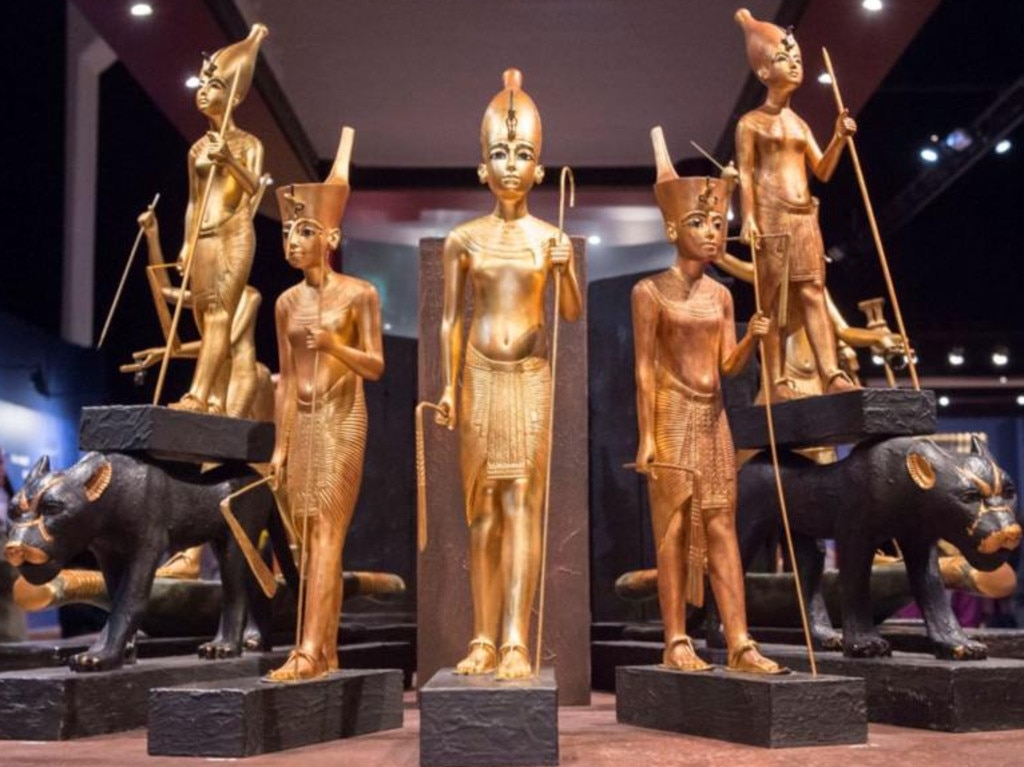
Some have theorised Tutankhamun suffered from his royal inbreeding, featuring deformities such as breasts and female hips. But there may be a simpler explanation. The statues of Egyptian pharaohs found in his tomb do not show him.
SANDS OF TIME
Hints of a mystery female pharaoh ruling between the reign of the mishappen heretic and the boy king have been around for about a century.
King Tut’s own tomb and treasures have long fanned speculation.
Many of his depictions seem surprisingly effeminate. Several statues even have breasts. Then there’s the shape of his tomb itself — a style normally associated with royal queens.
The idea the boy king inherited his kingdom from a lost queen flared again in 2015.

The burial mask of Egyptian Pharaoh Tutankhamun, who ruled Egypt from 1334 to 1325BC. Picture: AFP
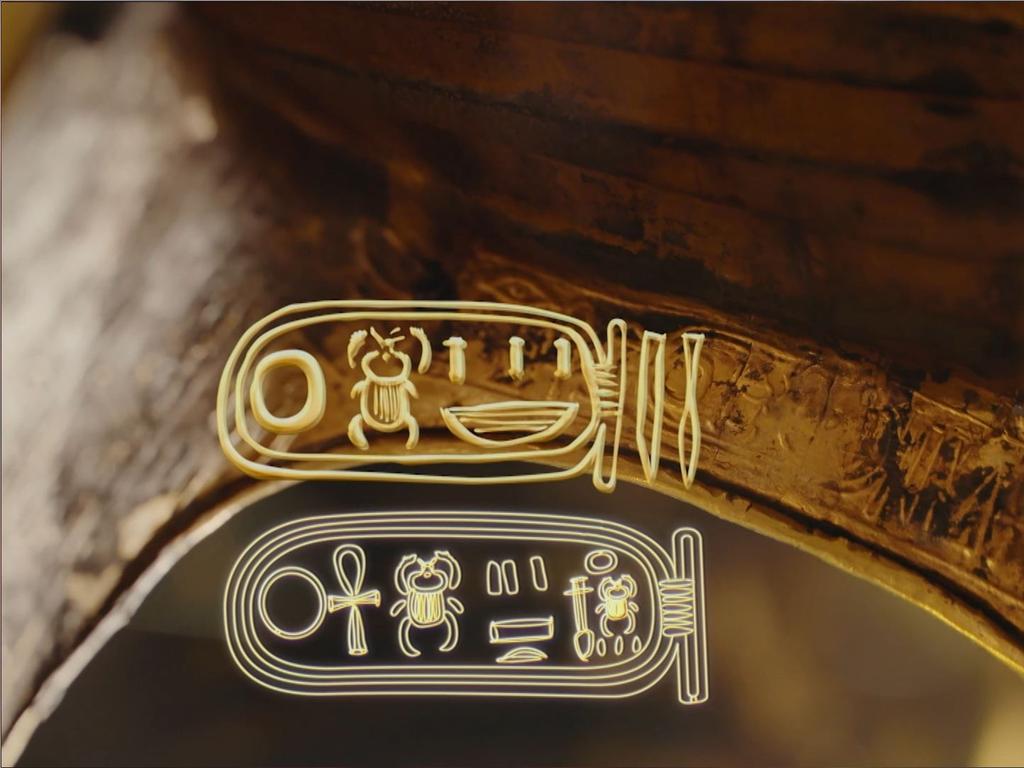
Inside the burial mask is an inscription. Tut’s name has been engraved on top of another. Screen capture: King Tut: Forgotten Treasure
British Egyptologist Nicholas Reeves pointed to some obscured scratches beneath Tutankhamun’s cartouche (name hieroglyphics) etched into the frame of his famous gold death mask. They appeared to spell the name Ankhkheperure Neferneferuaten.
“Blinded by the piece’s sheer beauty and enormous bullion worth, however, the world has looked and yet has completely failed to see — that the gold mask had never been intended for Tutankhamun at all,” Reeves stated at the time.
But who was Ankhkheperure Neferneferuaten?
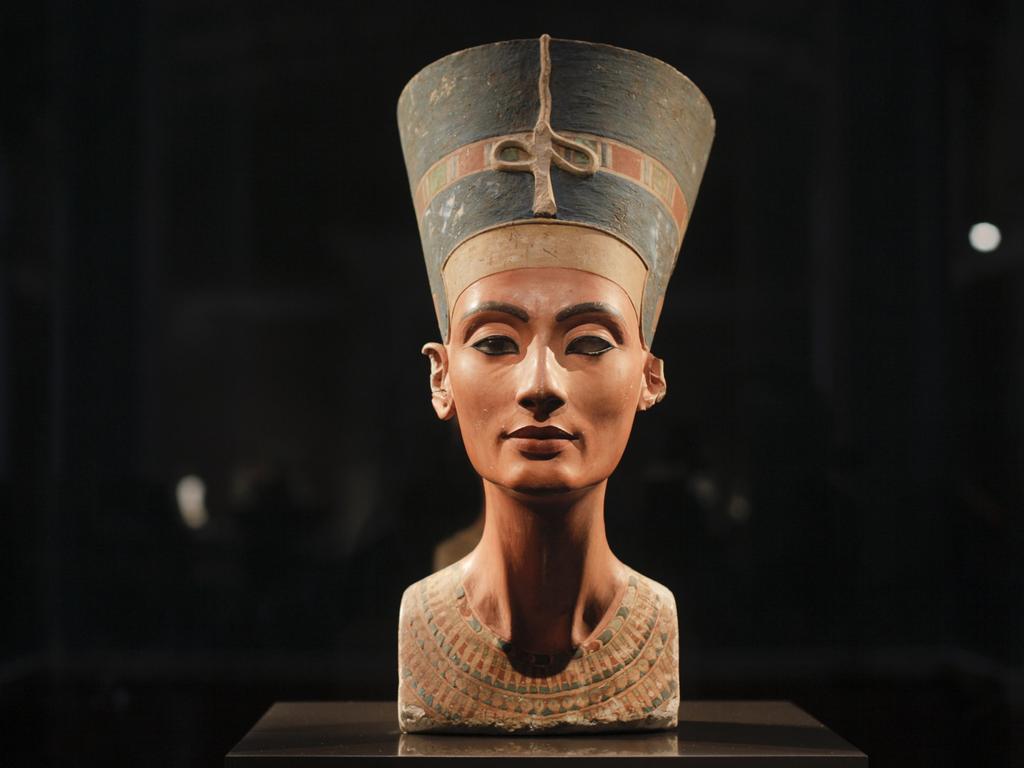
The famous 3,300-year-old bust of Queen Nefertiti. Many believe she ruled Egypt after the death of her husband, Akhenaten, and before her stepson Tutankhamun. Picture: AP
Professor Reeves, like many others, linked it to Akhenaten’s chief queen — Nefertiti. This was Tut’s stepmother.
It precipitated renewed speculation that Tut’s entire tomb and most of its treasures were originally intended for the subject of the world’s most copied work of art — the fine featured bust jealously guarded by the Berlin Museum.
Had she succeeded Akhenaten as pharaoh or regent, holding the throne until the young Tut came of age?
New research suggests not.
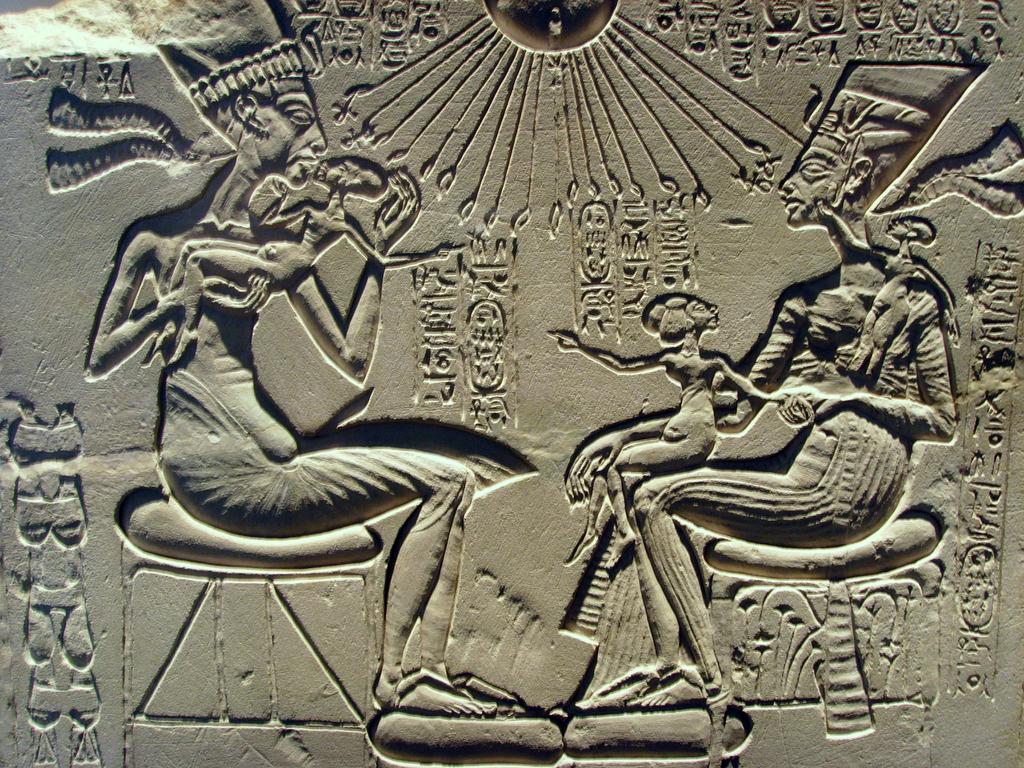
Pharoah Akhenaten, left, depicted with his chief wife Nefertiti (here wearing the crown of a pharaoh), right, playing with several of their daughters.
Instead, the world may have been blinded to the role his older sisters had played in guiding Egypt out of the heresy imposed by their father.
The freshly restored priests of Egypt’s old gods were determined to erase the memory of Akhenaten and his radical monotheistic religion. And a female pharaoh would likely have been too much for their bruised sensibilities.
But it appears they weren’t thorough enough.
TRACES IN THE TREASURE
The breasts on gilt-gold timber statues. The prominent earring holes (often plugged up) on almost every bust of his head — including his death mask.
Why were so many of Tut’s treasures so feminine?
And his famous 10kg gold death mask is by no means the only example of ‘rebranding’.
A fresh examination by French Egyptologists working to prepare Tutankhamun’s treasures for display in Cairo’s new Grand Museum has confirmed many examples of identity fraud.
Who was the priests responsible for Tut’s burial trying to conceal?
Egyptologist Marc Gabolbe of the University of Montpellier told the 2019 French documentary King Tut: Forgotten Treasure that a significant new clue had been found scattered in the wreckage left behind by ancient grave robbers.
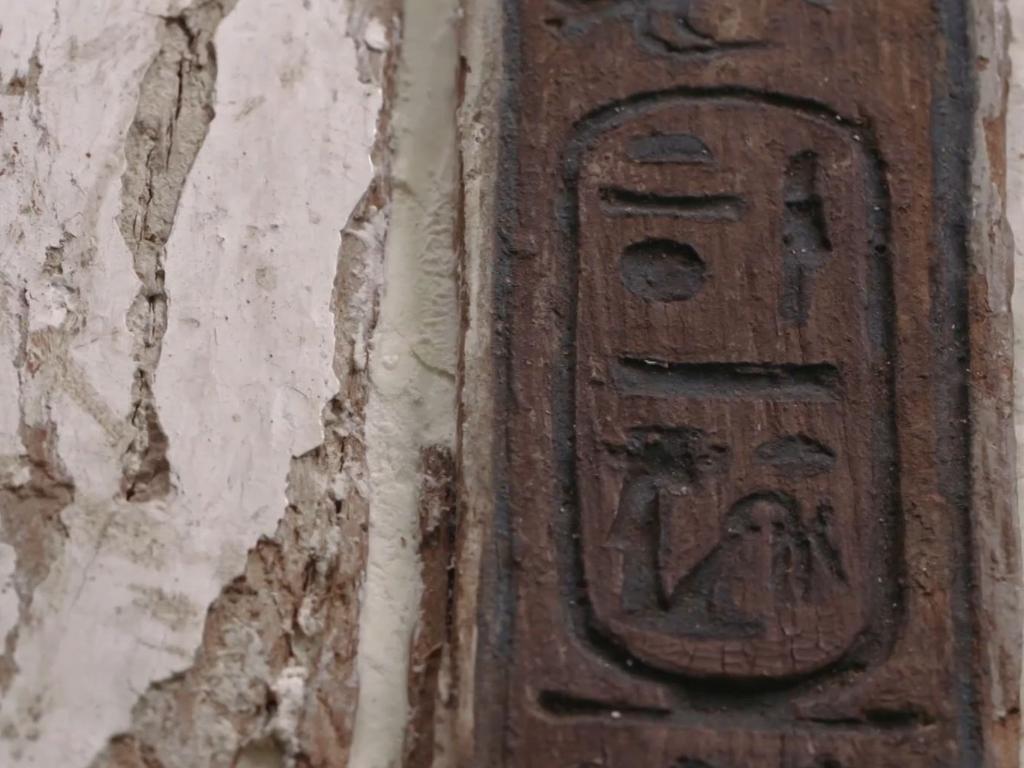
The cartouche of princess Meritaten on a recently reconstructed treasure chest that had been destroyed by the grave robbers who broke into Tut’s tomb. Screen capture: King Tut: Forgotten Treasure
Pieces of wood found scattered around the tomb and its entrance came from a smashed treasure chest which has now been restored. It held an identifying timber nameplate.
On it was the distinctive cartouches of Akhenaten and Tutankhamun’s eldest sister — Meritaten.
It was a relic of the overthrown heresy. A hand-me-down antique. A memory of times past.
But it may also be more than that.
Other treasures concealed more names.
A finely wrought curved piece of furniture still has the engraved name of Ankhkheperure (Beloved of Akhenaten) under the painted outlines of Tut’s cartouche.

This furniture handle has Tut’s cartouche stamped over the top of the name “Ankheperure”. Screen capture: King Tut: Forgotten Treasure
And then there’s one of four small gold replica sarcophagus built to preserve the dead boy king’s internal organs.
“Inside the lid, you can see Tutankhamun’s cartouches, but underneath there are small marks that were made prior,” Professor Gabolbe says. “From these examples, we can reconstruct the original cartouche, which is that of a pharaoh queen.”
Tut’s royal name is placed over one that reads “She who is effective for her husband”.

One of the small sarcophagi used to store Tutankhamun’s preserved internal organs. Screen capture: King Tut: Forgotten Treasure
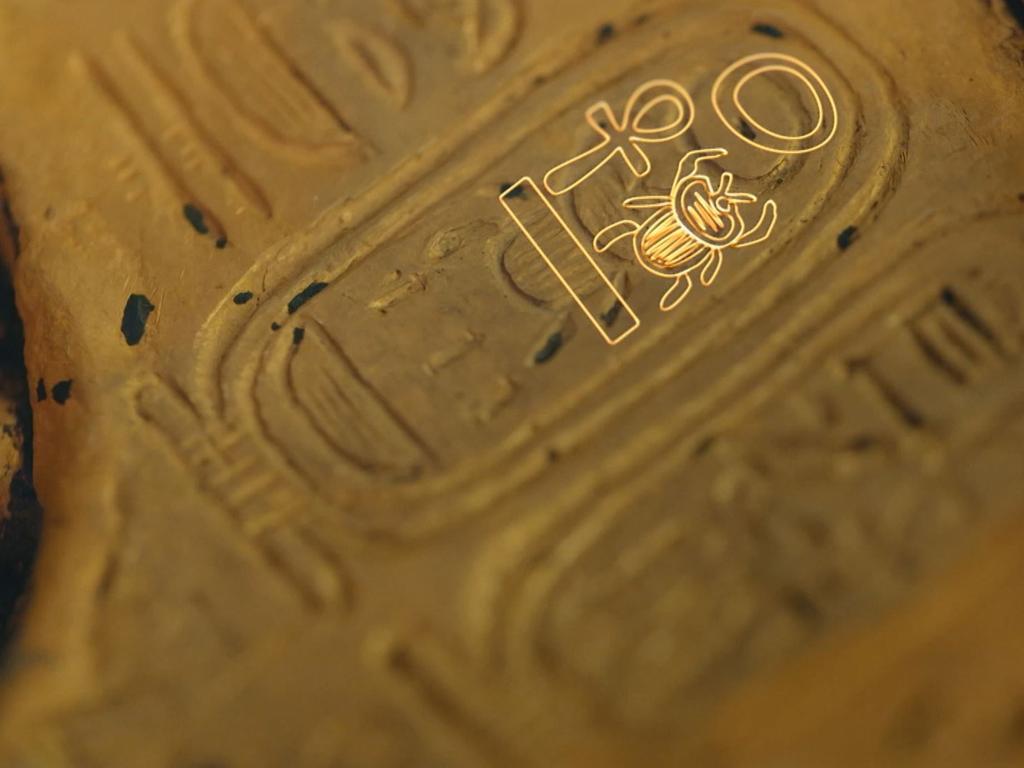
The reworked name inside. Screen capture: King Tut: Forgotten Treasure
Then there are the incredibly fine alabaster jars built to contain them. The four death masks that make up the lids are blatantly feminine. And the name on the sacred chest housing the whole precious bundle masks that name again.
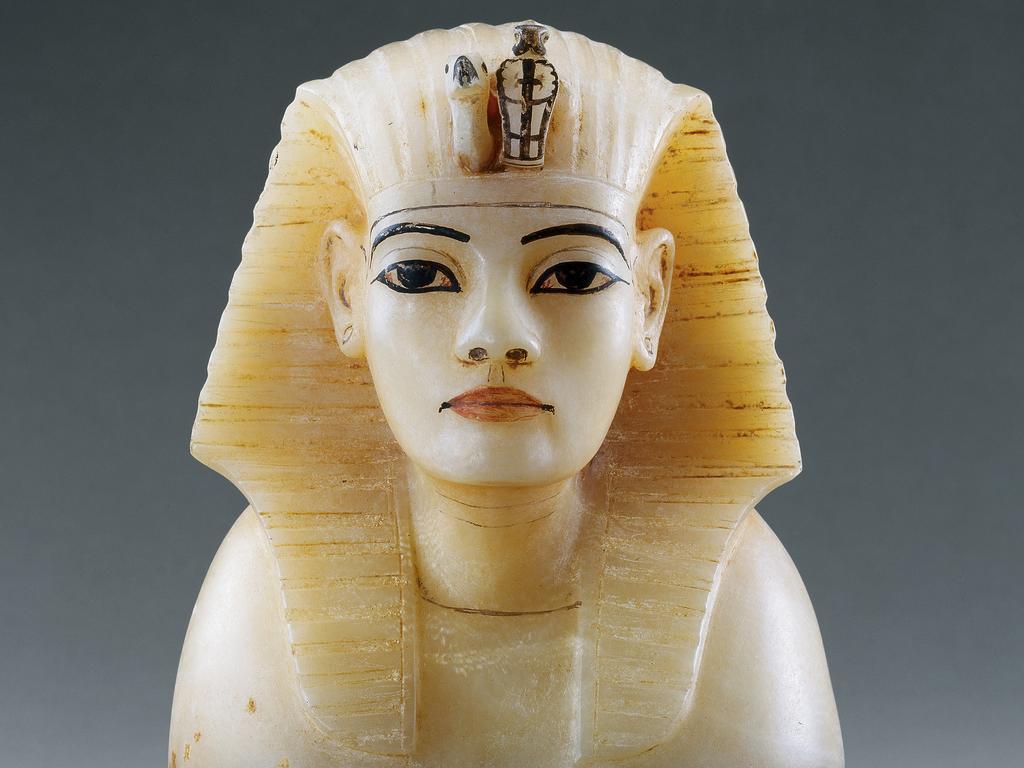
The distinctly feminine faces on Tut’s canopic jars.
But a precious-stone encrusted plate is the most revealing. It contains a depiction of the winged goddess Nut. Its mere existence shows it must have been made after Akhenaten’s monotheistic religion had been overthrown. But Tutankhamun crudely carved name barely masks the royal name “She who attends to her husband”.

Inside, Tut’s name has been scratched over that of another. Screen capture: King Tut: Forgotten Treasure
GAME OF THRONES
Exactly when and how Akhenaten died is unclear.
There is a distinctly murky period between 1335 and 1332BC, when the boy king Tutankhamun first made his mark as king on the ancient kingdom’s records and monuments.
This is no accident.
Every effort had been made by Egypt’s elite to expunge Akhenaten and his reforms from history.
It had been a reign that made Game of Thrones look like child’s play. He had dared to declare the existence of just one god — the Aten (sun god). He sank Egypt’s wealth into the fast-tracked construction of a new capital on the edge of the desert. He fought — and lost — a war over vital resources in what is now Syria.
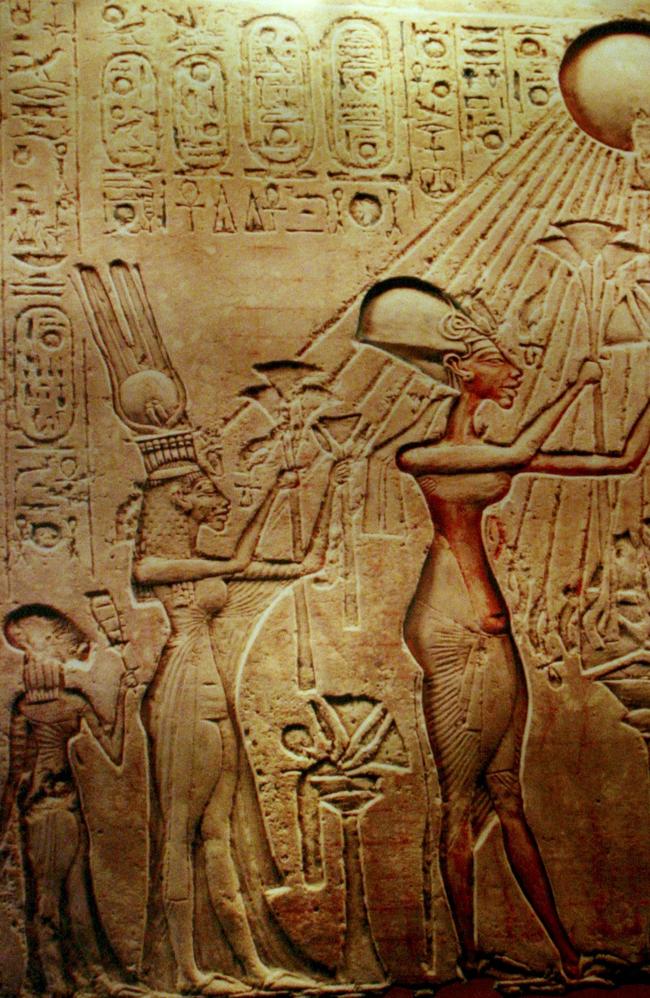
A stela at the Egyptian museum in Cairo showing Pharaoh Akhenaten, his Queen Nefertiti and their children worshipping the sun in the more natural artistic style of the time. Picture: AP
Audaciously, he also claimed the god Aten would only talk through him, his earthly representative, and not the usual slew of priests and prophets.
Naturally, this didn’t go down well.
The mass of out-of-work, broke and powerless priests would naturally become a source of disruption. And things only got worse as a devastating plague swept through Egypt at the height of his reign.
The royal family was not immune.
The few surviving engravings on Akhenaten’s Amarna tomb show him and his chief queen Nefertiti grieving over the death of at least three of their daughters. In one corner is an outline of a wet-nurse, and the baby Tutankhaten.
To guarantee the rule of his family, Akhenaten resorted to the traditional method of the pharaohs — intermarrying his own family.
When Akhenaten died, his tomb was defaced. His new capital, Amarna, was abandoned. Wherever his face or name could be found, it was gouged out.
The same seems to have applied to his immediate successors and family.
And that’s what makes things so difficult for Egyptologists.
But professor of art history Valérie Angenot, of the University of Quebec in Montreal, has put together some new clues.

A wall painting in the distinctively informal artistic style associated with Pharoah Akhenaten’s reign. Here, two princesses — Neferneferuaten and Meritaten -are shown, with one caressing the other’s chin. Such poses would become stylistic for specific identities.
THE PRINCESS BRIDES
While Professor Angenot’s work is yet to be published in a peer-reviewed journal, it appears to dovetail with the new French Egyptology evidence.
She told the annual meeting of the American Research Center in Egypt in Virginia late last month that several royal sculptures thought to show Akhenaten or Nefertiti were in fact of a mystery queen. And combining this with a study of the symbology of body language in Egyptian art may have revealed they are, in fact, two different identities.
And this was a direct result of the plague that had destabilised Akhenaten’s reign.
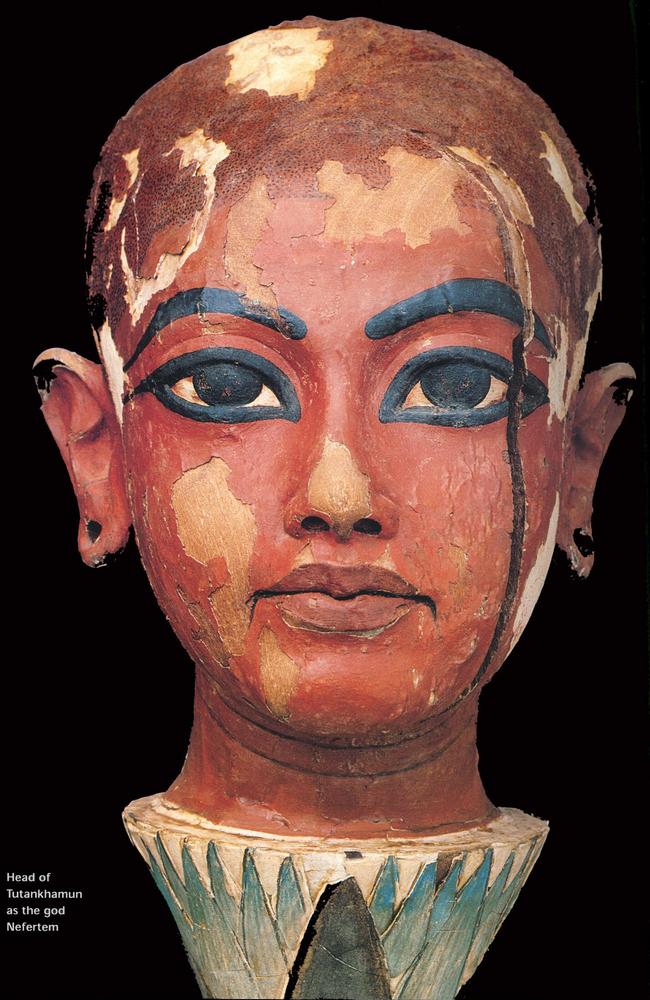
This painted timber head of Tutankhamun may instead be one of his older sisters. Ear-rings were not part of male costume in the era. Picture: Egyptian Supreme Council of Antiquities
She says Akhenaten’s chief consort did not survive to take up the crown of upper and Lower Egypt. There is an argument Nefertiti died in the 16th year of Akhenaten’s reign.
Instead, Professor Angenot believes, Tut’s older sisters — Neferneferuaten, 12, and Meritaten, 14, stepped into her place.
“I believe that because of all these deaths, he (Akhenaten) kind of tried to prepare his succession,” Angenot told Live Science. “He tried to prepare (each of) his four surviving children to be likely to rule at some point if the others died.”

While Akhenaten and his wife Nefertiti oversaw an artistic revolution in Egypt, they were not popular among the ruling elite for their radical beliefs and power-grab.
This involved marrying his own eldest daughter, Meritaten. Such a union of royal blood elevated her as next in line for the throne — and not some future husband from an outside family.
Akhenaten’s next eldest, Ankhesenpaaten, was promised to the toddler Tutankhaten (who later renamed himself Tutankhamen to honour the old gods) who went on to formally marry his sister (renamed Ankhesenamun) when he was crowned.
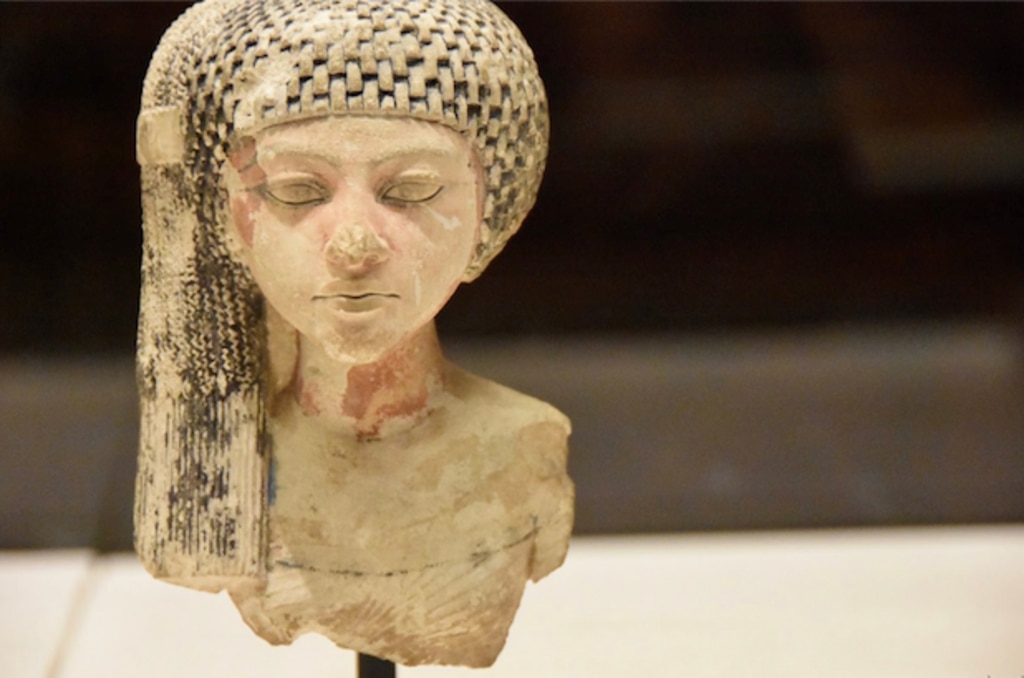
One of the few surviving statuettes identified as one of Akhenaten’s daughters. This is Meritaten.
Akhenaten’s youngest daughter was princess Neferneferuaten Tasherit. She was still too young to have children, but still older than the then-toddler Tut.
Some believe she died in the same plague that killed so many of her siblings. But Professor Angenot says there are inscriptions indicating it was her whom Akhenaten crowned pharaoh from his deathbed.
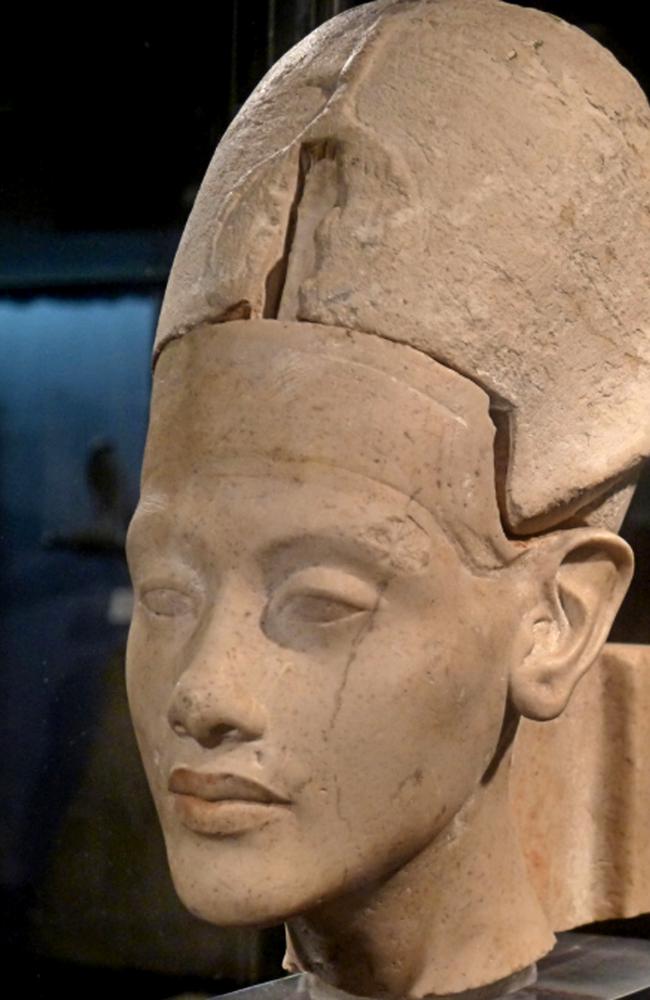
This statue, known as “Young Akhenaton” in the Kesner Museum Hanover, may instead be one of his daughters wearing the royal pharaoh crown. Dated to the end of Akhenaten’s reign, it shows a youthful and feminine face.
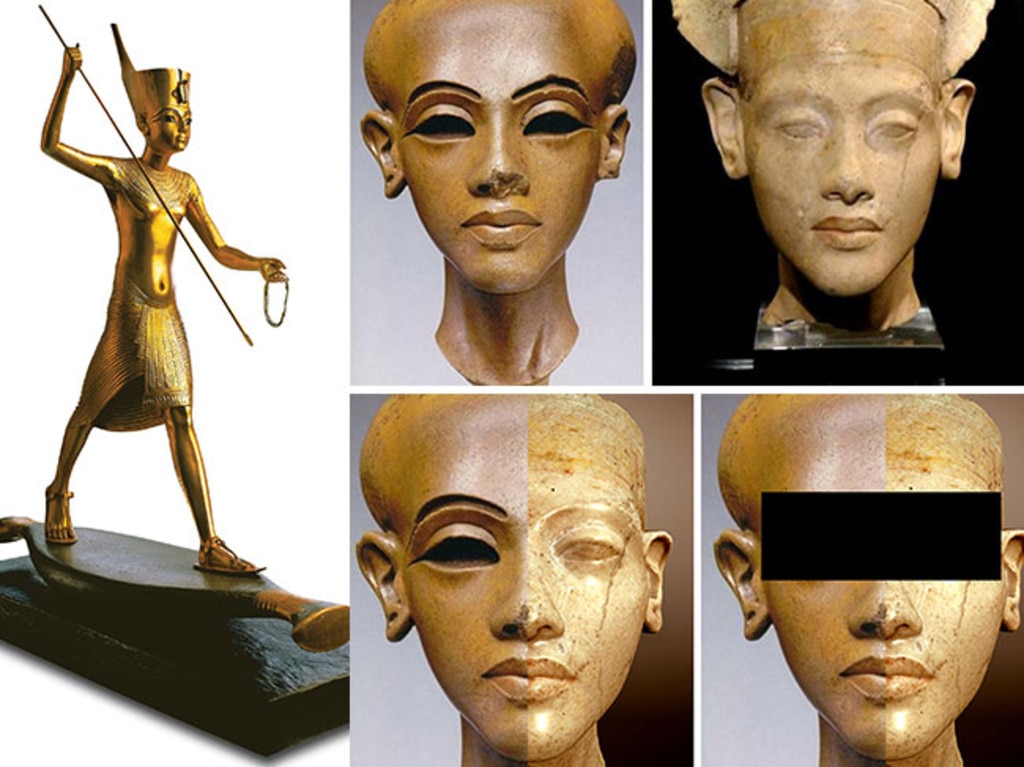
Comparison of the Hanover royal head and the princess head, Berlin ÄM 21223, using the Formwerk 3D model created by generalist Eik Jagemann. Other than the eyes, which were treated differently to receive inlays, the general shape of the face, the chin, the lips and the nose are a perfect match. The features are also found on some of Tut’s statues. Picture via Angenot
She argues anonymous sculptures of royal heads dating from the era — generally ascribed to Akhenaton and Nefertiti — are in fact portraits of the royal princess. This is the case of a particularly fine head with female features preserved at the Kestner Museum in Hanover, Germany, and previously identified as a “young Akhenaton”, although dated stylistically to the end of his reign,” the art historian says in a university release.
Professor Angenot also highlighted the similarities of this Hanover statue to the many feminine faces among King Tut’s treasures.
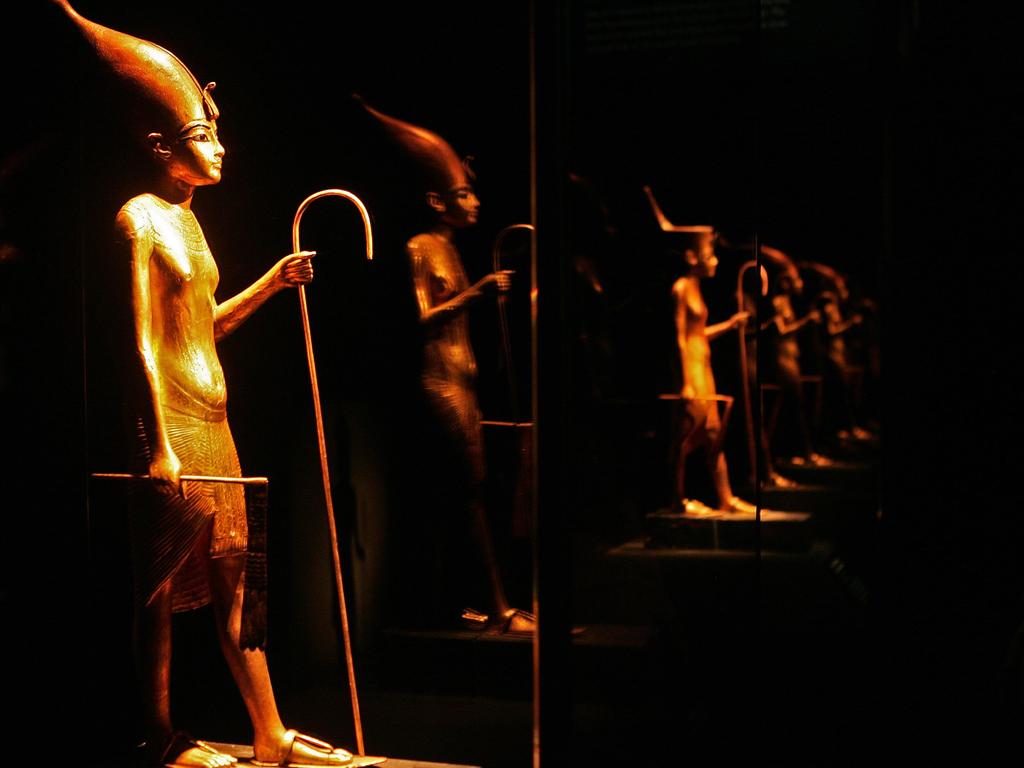
A golden figure depicting King Tutankhamun as the King of Upper Egypt. But is it really one of his older sisters, whose reign has been concealed from history? Picture: AFP
WHAT’S IN A NAME
At the centre of all the confusion is the name Neferneferuaten.
Ankhkheperure Neferneferuaten is a name that keeps popping up as the mystery queen who came after Akhenaten.
Is she and princess Neferneferuaten Tasherit one and the same?
Or was it a name adopted by Nefertiti when she became sole pharaoh? Or Meritaten?
Adding to the confusion is the habit of Egyptian royalty to have two names: a birth name, and a reign name.
“The only candidate who had this name as a birth name was the princess Neferneferuaten,” Professor Angenot told LiveScience. “The problem was that she was the youngest surviving daughter, so everybody thought she could not have had precedence over her siblings to sit on the throne.”
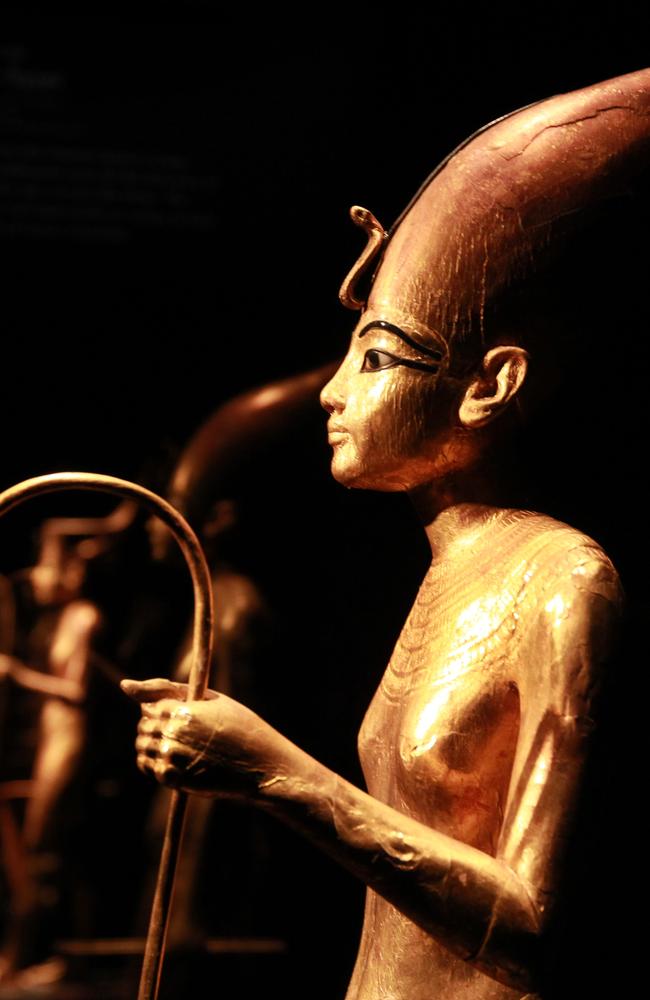
Tutankhamun and the Golden Age of the Pharaohs exhibition at the Melbourne Museum showed a gold statue of Tutankhamun as King of Lower Egypt. Picture: Supplied
Professor Angenot says evidence for this is in the creative and lifelike — though highly symbolic — art that exploded under the fresh-thinking Akhenaten.
The pharaoh himself was openly displayed as disfigured, with a distended belly, elongate face and feminine hips. It was part of a newly emerging art movement, trending away from the formally stylised images of the past towards much more lifelike and intimate scenes.
One clue they offered was in this was the way his family was often shown touching each other. In the case of his daughters, they would be caressing each others’ chins.

An unfinished stone stele honouring two unidentified royals. Originally thought to show the joint-pharaohs Akhenaten and Nefertiti. Picture: Supplied

The unfinished stele in the Berlin Museum has been identified as showing Akhenaton reigning with a male coregent; Akhenaton and his father Amenhotep III; and Akhnaton and his wife Nefertiti after she was raised to the rank of “king”.
It’s a subtle pose. But it is significant as it isn’t accidental. Such positionings were being associated with particular individuals.
It’s a pose found in an unfinished stone stele honouring two unidentified royals. Originally thought to show the joint-pharaohs Akhenaten and Nefertiti, Professor Angenot now believes it represents the sisters Neferneferuaten and Meritaten. As joint pharaohs, they would share a joint coronation name. And the unfinished stele had space set aside for three cartouches.
“The act of “caressing the chin” depicted on the stele appears in the Egyptian iconographic repertoire only for the daughters of Akhenaton and Nefertiti,” the statement says.
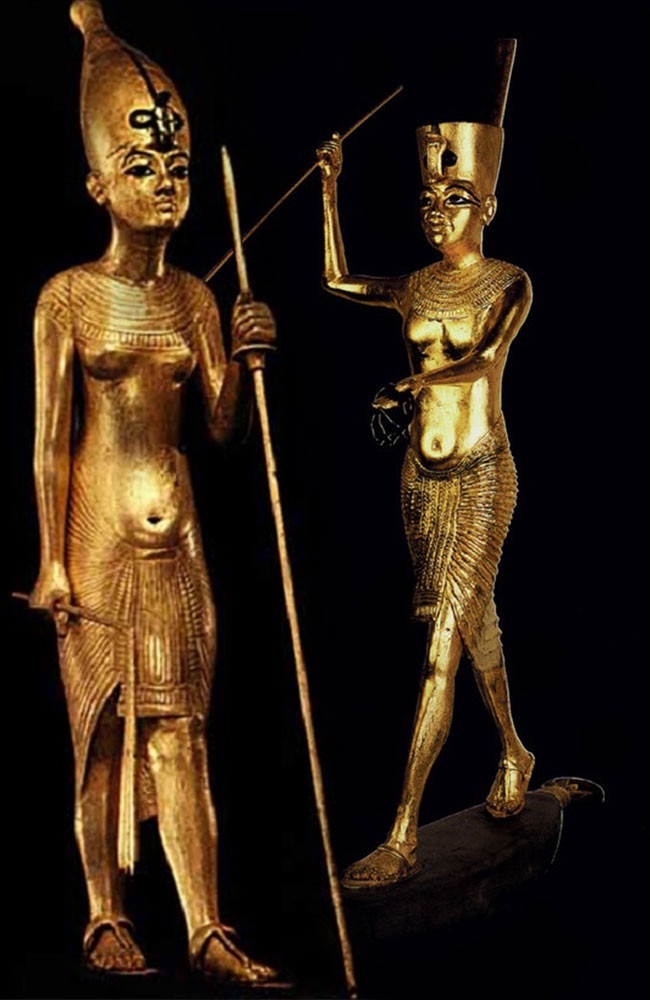
These two gold-covered statues found in Tutankhamun’s tomb may not be of the boy king. Instead, they may be of his two older sisters — Neferneferuaten and Meritaten — who may have ruled Egypt jointly after the death of their father.
THE CHILD QUEENS
Princess Neferneferuaten took the throne, the professor says, with the teenage Meritaten adopting the ritual role of chief royal consort.
“It looks like after one year, Meritaten had herself crowned as pharaoh, as well,” she says.
It wasn’t without precedent. Or controversy.
Egypt had had female pharaohs before — Hatshepsut and Sobekneferu.
And Akhenaten had already done something radical: Among his revolutionary acts was to make his favourite queen, Nefertiti, a full equal in rank and status. Essentially, a co-pharaoh.
Their looted statues — one wearing the crown of Upper Egypt, the other of Lower Egypt — were later bundled among Tutankhamun’s possessions.
The bejewelled plate of the goddess Nut also found among Tut’s treasures indicates it was these child queens that had set about restoring the old religions and moving the capital back to Thebes. Not Tutankhamun, as is widely reported.
But the priests who cemented King Tut’s rule hated Akhenaten with a vengeance for having stripped away their gods, their wealth and their power. And they wold have been scandalised by any following co-female rule, Professor Angenot says.
“That’s why we have such little information,” Angenot says, “because everything was destroyed after their deaths.”

A royal figure wearing the crown of Upper Egypt, from the Tutankhamun and the Golden Age of the Pharaohs exhibition.
LOST IN TRANSLATION
If Meritaten or Neferneferuaten — or both — took the throne, it would have lasted no more than three years.
The mystery queen(s) simply disappeared.
She wasn’t buried in the tomb — with the grave goods — she had prepared for herself (unless the recent excitement about potential hidden chambers in Tut’s tomb proves otherwise).
Professor Angenot’s interpretation remains highly controversial. And the idea the mystery female pharaoh was a rebranded Nefertiti remains the favoured interpretation among most Egyptologists. But that’s how history works.
The most likely story to fit the few available facts and records remains the accepted account, until some new fact comes along — and is confirmed.
In this case, the archaeological record hints Nefertiti had adopted Neferneferuaten as part of her royal name early in Akhenaten’s name. So it isn’t all that great a reach to believe she revived its use after her controversial husband’s death, when she wanted to set aside an identity that had become stigmatised by his controversial rule.
And there’s potentially another mystery pharaoh belonging to the same few years: Smenkhakare. Nobody knows who this was. Was it just another name used by whomever had also adopted Neferneferuaten? Or were the multiple contenders for the throne, creating a kind of pharoic schism?
What we know for sure is the boy-king Tutankhamun died aged about 17 in 1318BC. He’d just completed 10 years of rule, and was succeeded by an ambitious courtier who was also likely his grandfather.
Egypt’s game of thrones was brutal.
Exactly how brutal is still being revealed.
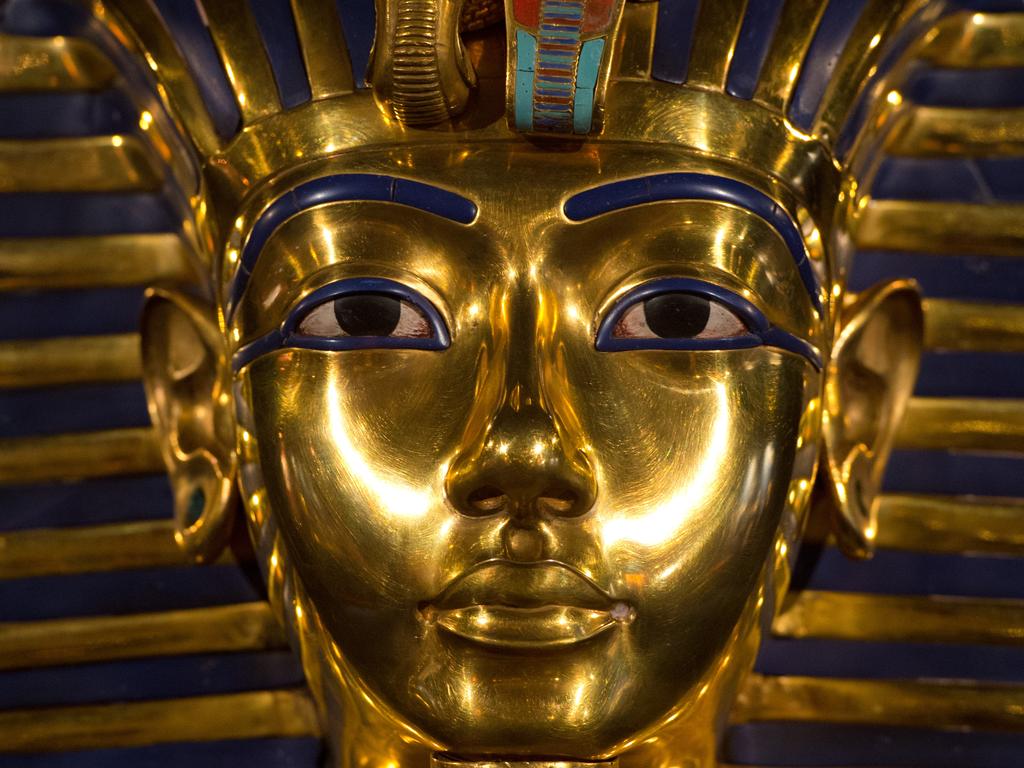
Egyptian pharaoh Tutankhamun’s death mask. Picture: AFP